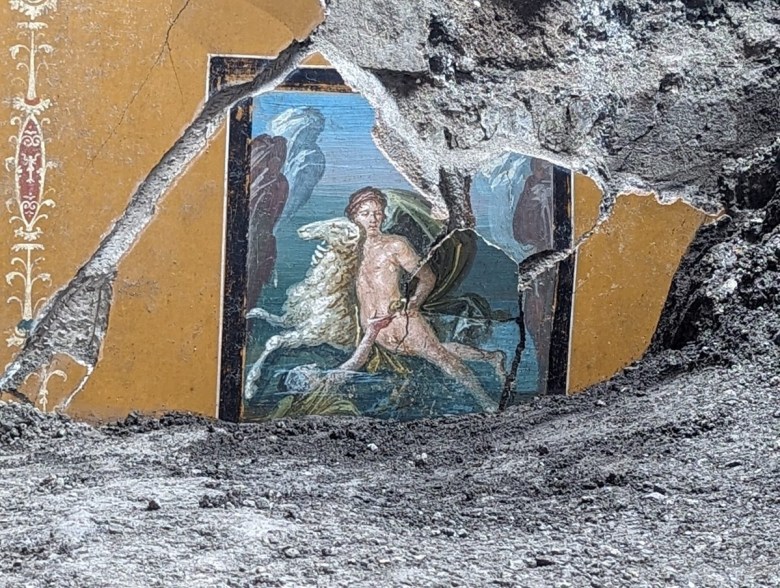Archaeologists in Italy recently uncovered a 2,000-year-old fresco in remarkable condition on the walls of the House of Leda, a Pompeii mansion under excavation since 2018 that’s recognized for its exquisite art. Painted as if it were a framed artwork on a yellow wall, the fresco depicts the Greek mythological tale of Phrixus and Helle with vibrant pigments and crisp dimensions that have been preserved beneath volcanic ash since 79 CE, after the eruption of Mount Vesuvius.
According to the tale, Phrixus and Helle were twin children born to the Boeotian king Athamas and a nymph named Nephele. Athamas remarried to a mortal woman named Ino who hated her step-children and devised a plan to have Phrixus sacrificed by the order of an oracle so she could secure her own son’s right to the throne. Phrixus and Helle escaped from Boeotia with the help of the Golden Ram that flew them across the sea, but Helle sadly fell off of its back mid-flight and drowned in the ocean. Phrixus found safety with King Aeëtes of Colchis, and later married his daughter Chalciope.
The fresco depicts the frequently referenced scene of Helle drowning while reaching out for her brother’s hand as the Golden Ram prepares to soar away.
Gabriel Zuchtriegel, the director of the Pompeii Archaeological Park, drew connections between the Greek tale and the current events impacting Italy in an interview with the Guardian, noting that “history has repeated itself” and that Phrixus and Helle were “two refugees at sea, a brother and sister, forced to flee because their stepmother wants rid of them and she does so with deception and corruption.”
The work is the most recent discovery at the House of Leda, which is rife with additional examples of extravagant paintings including the 2018 discovery of an erotic fresco depicting Zeus’s “seduction” (though the degree of consent remains nebulous throughout different renditions) of Spartan queen Leda by taking the form of a swan on a wall in one of the mansion’s bedrooms.
The discovery came along during the conclusion of the Great Pompeii Project that was spearheaded by the Italian government in 2012 to further excavate, stabilize, and restore structures across the ancient city amidst research efforts, climate emergencies, and increased tourism. Earlier this month, Zuchtriegel shared in an official statement that the next phase for Pompeii was to develop it from an urban planning standpoint that engages surrounding towns and cities and promotes further educational opportunities for history and culture.
“Just as the ancient city was part of a cultural landscape, even today there should be no rigid boundaries between inside and outside,” Zuchtriegel said.

